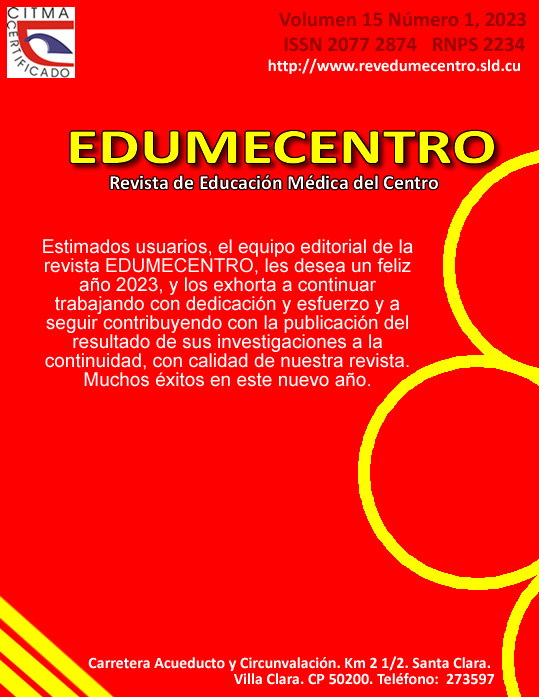Cardiopulmonary-cerebral resuscitation in the Medicine career: differences between study plans D and E
Keywords:
cardiopulmonary resuscitation, health postgraduate programs, education, medicalAbstract
Background: basic cardiopulmonary-cerebral resuscitation is present as its own course in the "D" and "E" study plans of the Medicine career; although in both the organization of the process has its particularities.
Objective: to specify the differences in terms of structure, teaching process and academic results in the teaching of basic cardiopulmonary-cerebral resuscitation, between the "D" and "E" study plans of the Medicine career.
Methods: a descriptive, prospective, cross-sectional study was carried out at Cienfuegos University of Medical Sciences from 2017 to 2019. Theoretical and empirical methods were used. To compare results, the student universe was used in both years, to evaluate satisfaction and quality a simple random sample. Descriptive statistical techniques were used. For both courses, a similar scenario and faculty were used.
Results: the differences between both plans derive from the non-personal components of the teaching process; plan “D” has 20 hours and plan “E” 40, which expands its contents. All the topics and objectives of plan “D” were included in plan “E”. There was similarity in the general (80.4% and 75.2%) and quality (50.6% and 53.1%) school grades in both years. The fulfillment of the expectations, satisfaction and quality of the process was valued as very high and high (more than 98%) by the students in both courses.
Conclusions: although there were differences in the teaching-learning process between both plans, there was no impact on student satisfaction, quality of the teaching process, or academic results. The “E” plan variant is more comprehensive for basic life support training.
Downloads
References
1. Aranda García S, Herrera Pedroviejo E, Abelairas Gómez C. Basic Life-Support Learning in Undergraduate Students of Sports Sciences: Efficacy of 150 Minutes of Training and Retention after Eight Months. Int J Environ Res Public Health [Internet]. 2019 [citado 03/12/2022];16(23):[aprox. 22 p.]. Disponible en: https://www.mdpi.com/1660-4601/16/23/4771
2. Cheng A, Magid DJ, Auerbach M, Bhanji F, Bigham BL, Blewer AL, et al. Resuscitation Education Science: 2020 American Heart Association Guidelines for Cardiopulmonary Resuscitation and Emergency Cardiovascular Care. Circulation [Internet]. 2020 [citado 03/12/2022] 20;142:S551-S579. Disponible en: https://www.ahajournals.org/doi/10.1161/CIR.0000000000000903
3. Dobbie F, MacKintosh AM, Clegg G, Stirzaker R, Bauld L. Attitudes towards bystander cardiopulmonary resuscitation: Results from a cross-sectional general population survey. PLoS One [Internet]. 2018 [citado 03/12/2022]. 2018;13(3):e0193391. Disponible en: https://doi.org/10.1371/journal.pone.0193391
4. McCoy CE, Rahman A, Rendon JC, Anderson CL, Langdorf MI, Lotfipour S, et al. Randomized Controlled Trial of Simulation vs. Standard Training for Teaching Medical Students High-quality Cardiopulmonary Resuscitation. West J Emerg Med [Internet]. 2019 [citado 03/12/2022];20(1):[aprox. 7 p.]. Disponible en: https://www.ncbi.nlm.nih.gov/pmc/articles/PMC6324716/
5. Navarro Machado VR, Falcón Hernández D, León Regal M, Chávez Amaro DM. Reanimación cardiopulmocerebral en el plan de estudios D de la carrera de medicina. Educ Med Super [Internet]. 2017 [citado 21/12/2022];31(4):[aprox. 22 p.]. Disponible en: http://www.ems.sld.cu/index.php/ems/article/view/1160/589
6. Ministerio de Salud Pública. Comisión nacional de carrera de medicina. Programa del curso de contenido propio, reanimación cardiopulmonar. La Habana: Universidad de Ciencias Médicas de La Habana; 2015.
7.Álvarez Sintes R. Plan de estudio de medicina: ¿nueva generación? Rev Haban Cienc Med [Internet]. 2017 [citado 22/12/2022];16(5):[aprox. 8 p.]. Disponible en: http://www.revhabanera.sld.cu/index.php/rhab/article/view/2123
8. Ojeda González J, Sánchez Sarría O, Ortiz Santiesteban L, Nieto Prendes P. Percepción de los alumnos sobre la adquisición de las habilidades al concluir la asignatura de Reanimación Cardiopulmonar Cerebral Básica. Medisur [Internet]. 2018 [citado 21/12/2022];16(6):[aprox. 5 p.]. Disponible en: http://medisur.sld.cu/index.php/medisur/article/view/3764
9. Ministerio de Salud Pública. Comisión nacional de carrera de medicina. Plan de estudio E de la carrera de Medicina. La Habana: Universidad de Ciencias Médicas de La Habana; 2019.
10. Navarro Machado VR, Cazull Imbert I, Corona Pérez RR, Gutiérrez Castro R, Ferreiro Rodríguez Y, Gómez Castellanos RF, et al. Guía para la enseñanza del apoyo vital socorrista. Consenso para el proyecto de formación e investigación en apoyo vital. Cienfuegos, 2018. Medisur [Internet]. 2018 [citado 23/12/2022];16(6):[aprox. 18 p.]. Disponible en: http://www.medisur.sld.cu/index.php/medisur/article/view/4183
11. Nakanishi T, Goto T, Kobuchi T, Kimura T, Hayashi H, Tokuda Y. The effects of flipped learning for bystander cardiopulmonary resuscitation on undergraduate medical students. Int J Med Educ [Internet]. 2017 [citado 03/12/2022]22;8:[aprox. 7 p.]. Disponible en: https://www.google.com/url?sa=t&rct=j&q=&esrc=s&source=web&cd=&cad=rja&uact=8&ved=2ahUKEwj1hca78ML-AhWaQjABHZQDAxsQFnoECA0QAQ&url=https%3A%2F%2Fpubmed.ncbi.nlm.nih.gov%2F29278526%2F&usg=AOvVaw0gLyPrWHaMYqePni9NvB_R
12. SchroÉder H, Henke A, Stieger L, Beckers S, Biermann H, Rossaint R, et al. Influence of learning styles on the practical performance after the four-step basic life support training approach. An observational cohort study. PLoS ONE [Internet]. 2017 [citado 03/12/2022];12(5):e0178210. Disponible en: https://www.google.com/url?sa=t&rct=j&q=&esrc=s&source=web&cd=&cad=rja&uact=8&ved=2ahUKEwinkIj58ML-AhV-TDABHcb8CocQFnoECA4QAQ&url=https%3A%2F%2Fpubmed.ncbi.nlm.nih.gov%2F28542636%2F&usg=AOvVaw3ZhkJ9U89V56YNKHd82hv1
13. Bylow H, Karlsson T, Lepp M, Claesson A, Lindqvist J, Svensson L, Herlitz J. Learning Outcome After Different Combinations of Seven Learning Activities in Basic Life Support on Laypersons in Workplaces: a Cluster Randomised, Controlled Trial. Med Sci Educ [Internet]. 2020 [citado 03/12/2022]18;31(1):161-173. Disponible en: https://www.google.com/url?sa=t&rct=j&q=&esrc=s&source=web&cd=&cad=rja&uact=8&ved=2ahUKEwinkIj58ML-AhV-TDABHcb8CocQFnoECA4QAQ&url=https%3A%2F%2Fpubmed.ncbi.nlm.nih.gov%2F28542636%2F&usg=AOvVaw3ZhkJ9U89V56YNKHd82hv1
14. Labrandero M, Martínez González A, García Minjares M, Guerrero Mora L, Sánchez Mendiola M. Desempeño académico y egreso en 25 generaciones de estudiantes de la Facultad de Medicina de la UNAM. Educ Med [Internet]. 2019 [citado 03/12/2022] Disponible en: https://doi.org/10.1016/j.edumed.2019.05.003
15. García Gascón Á, Gorguet Pi M, Cisneros Prego E, Chi Rivas JC. Insuficiencia académica en estudiantes de primer año de medicina. Medisan [Internet]. 2019 [citado 07/12/2022];23(6):[aprox. 10 p.]. Disponible en: http://www.medisan.sld.cu/index.php/san/article/view/2919
Published
How to Cite
Issue
Section
License
Los autores que publican en esta revista están de acuerdo con los siguientes términos:- Los autores/as conservarán sus derechos de autor y ceden a la revista el derecho de primera publicación de su obra, el cuál estará simultáneamente sujeto a una Licencia Creative Commons Reconocimiento-NoComercial-CompartirIgual 4.0 Internacional (CC BY-NC-SA 4.0) que permite a terceros compartir la obra siempre que se indique su autor y su primera publicación esta revista.
- Los autores pueden establecer por separado acuerdos adicionales para la distribución no exclusiva de la versión de la obra publicada en la revista (por ejemplo, situarlo en un repositorio institucional o publicarlo en un libro), con un reconocimiento de su publicación inicial en esta revista.
- Se permite y se anima a los autores a difundir sus trabajos electrónicamente (por ejemplo, en repositorios institucionales o en su propio sitio web) antes y durante el proceso de envío, ya que puede dar lugar a intercambios productivos, así como a una citación más temprana y mayor de los trabajos publicados (Véase The Effect of Open Access) (en inglés).










